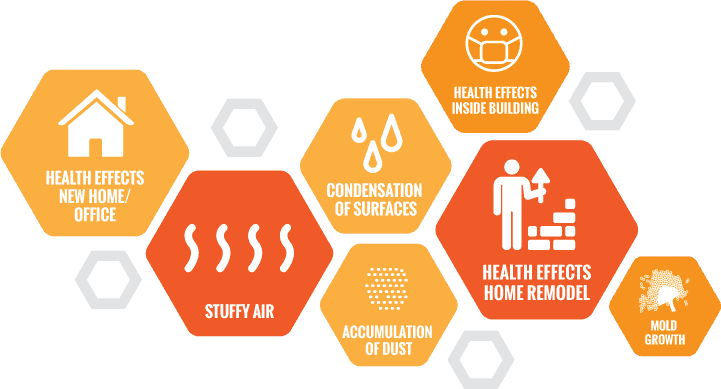Indicators of possible indoor air quality problems may include…

Indoor Air Quality (IAQ) refers to the quality of the air we make contact with and breathe inside of buildings. A focus of building sciences is to design and engineer buildings that provide a comfortable and healthy environment for their occupants. This can be accomplished by minimizing indoor pollutants, maintaining comfortable temperatures, and limiting excessive humidity.
Health effects from poor indoor air quality may be felt immediately or manifest themselves slowly over years.
Indoor Pollutants can include:
Biological
- Mold
- Bacteria
- Viruses
- Animal parts or by-products (Dander, waste, etc.)
- Plant parts or by-products (Pollen, etc.)
Chemical/Gas/Metal/Mineral
- Carbon Dioxide
- Carbon Monoxide
- Formaldehyde
- Hydrogen Sulfide
- Nitrogen Dioxide
- Volatile Organic Compounds (VOCs)
- Secondhand Smoke (from cigarettes/cigars)
- Radon
- Lead (In Pre-1978 Homes)
- Asbestos
Some common effects may include irritation (eyes, nose, and throat), headaches, dizziness, and fatigue. Although less common, long-term effects may include diseases that affect the lungs/skin/heart and cancer.
Indicators of possible indoor air quality problems may include:
- Health effects that manifest themselves when someone moves to a new home/office or a different location inside of a building,
- Health effects that manifest themselves after someone remodels a home or business,
- Health effects that manifest themselves after pesticide has been used inside of a building,
- Stuffy air,
- Condensation of surfaces,
- Mold growth,
- Large accumulations of dust on surfaces,
What can be done?
- Stop leaks and dry them as soon as they are found to minimize mold problems and off-gassing of water damaged building materials,
- Monitor humidity and verify that it is maintained between 40 and 55% throughout the year. (problems can form once it reaches 65% for a prolonged period of time),
- Keep your home free of tobacco smoke (Cigarettes, Cigars, Pipe smoking),
- Clean your home on a regular basis to limit dust and debris build-up,
- Use ecologically friendly non-toxic cleaning chemicals when possible,
- Use proper ventilation for good air exchange,
- Use air conditioning filters that have a good balance between efficiency and air filtration rate,
- Change or clean air conditioning filters on a regular basis,
- Test for indoor pollutants (Mold, Bacteria, Animal/Plant parts and by-products, Volatile Organic Compounds, Carbon Dioxide and Carbon Monoxide, Lead, Asbestos, Radon, etc.).
The most common indoor air quality item inspected/tested/assessed
Most of the concerns that our customers talk to us about deal with water damage and mold growth. For more information on mold and mold related services please click on the following page link: www.fsginspections.com/mold-related-services When we perform a mold assessment we also document observable moisture problems, temperature, and humidity.
Monitoring and Data Logging environmental variables over time
We have the capability to monitor and data log temperature, humidity, Carbon Dioxide, Carbon Monoxide, Formaldehyde, Hydrogen Sulfide, Nitrogen Dioxide and TVOCs over time with the use of data logging equipment. This can allow for possible trends to surface, which may shed light on transient indoor air quality problems. Please give us a call so we can understand what you need regarding data logging and provide you with a proposal for services. If you need another variable monitored and data logged give us a call and we may be able accommodate.
Volatile Organic Compound Testing
We can perform testing for Volatile Organic Compounds using a suma canister and EPA TO-15. We primarily do this testing for business and industrial applications when a business or the government want to see if Occupational Safety and Health Administration (OSHA) Permissible Exposure Limits (PELs) or National Institute for Occupational Safety and Health (NIOSH) Recommended Exposure Limits (RELs) have been surpassed or if certain chemicals are identified on the test results. EPA TO-15 results are usually too technical for a homeowner to get actionable information from because many household cleaners contain a variety of chemicals.
Miscellaneous Testing of other pollutants
We can test for pollen, animal dander, dust mites, and many other indoor pollutants. Please give us a call on (407) 721-0594 so we may understand your needs and provide you a proposal for services.
Tests we do not perform
We do not perform radon, lead, or asbestos testing. If you have concerns about any of those pollutants please give us a call and we may be able to direct you to some local resources that perform those types of testing. If you would like to test for radon yourself or lead yourself, you can buy kits online or locally at EMSL Analytical in Orlando.
EMSL Radon Home Test Kit: http://emsl.com/ProductCatalogDetails.aspx?Name=Radon-Gas-Test-kit—retail&ProductID=RRADNGTK
EMSL Lead Paint Test Kit: http://emsl.com/ProductCatalogDetails.aspx?Name=D-Lead-Paint-test-kit&ProductID=8708319
Please keep in mind that there are advantages to hiring state licensed Asbestos, Radon, and Lead Assessors. A licensed professional can review your home and formulate a strategy for their work and testing locations. They can also give you personalized information and guidance that you may not get from a laboratory analysis alone.
